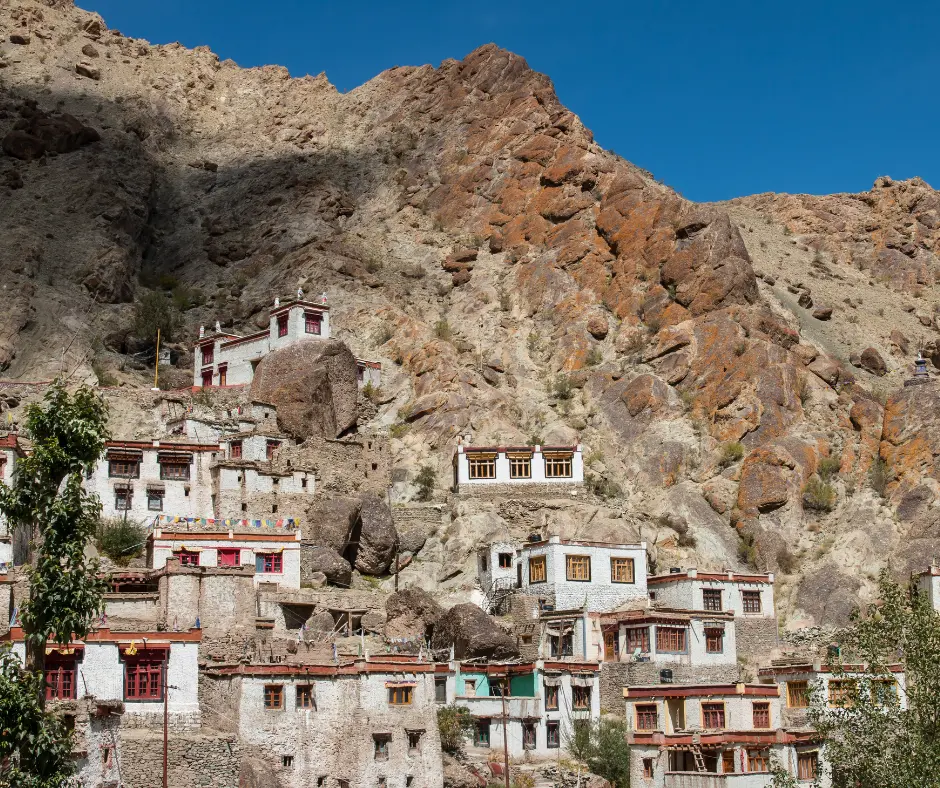Ladakh’s historic sites are inextricably linked with its breathtaking natural landscape. Ancient monasteries, towering gompas, and ancient ruins are often nestled amidst dramatic mountain peaks, serene lakes, and arid deserts. This harmonious coexistence of human history and natural beauty has shaped Ladakh’s unique character and cultural identity. The region’s pristine environment, with its crystal-clear rivers, snow-capped mountains, and diverse flora and fauna, has provided inspiration and sustenance for generations of Ladakhis, influencing their art, religion, and way of life.
Monastic Retreats: Spiritual Sanctuaries Among the Peaks

Arriving at a monastery like Hemis or Thiksey. The whitewashed walls of these serene gompas stand out against the backdrop of craggy mountains and deep blue skies. These monasteries aren’t just places for spiritual reflection; they are masterpieces designed to blend seamlessly with Ladakh’s dramatic landscape. The architecture, with its local stone and timber, is crafted to withstand the extreme weather while harmonizing with the natural world around it.
Inside, vibrant murals and intricate carvings bring the surrounding landscape into the sacred space, reflecting a spiritual connection with the natural world. The location of these monasteries is chosen not just for its beauty but for its ability to provide a tranquil retreat, aligning the monks’ spiritual practices with the rhythms of nature.
Royal Homes Embracing the Landscape

Stok Palace, a majestic edifice nestled near the Indus River, is a testament to the harmonious coexistence between royalty and the land. The palace’s traditional architecture, rooted in Ladakhi heritage, seamlessly blends with the serene surroundings. Its carefully designed gardens and courtyards are an integral part of the natural beauty of the region, creating a living tapestry of Ladakh’s cultural heritage.
The palace’s architectural elements, such as its intricate wood carvings and vibrant murals, reflect the rich artistic traditions of Ladakh. The courtyards, adorned with colorful prayer flags and lush greenery, more than just a historical monument, is a symbol of the deep connection between the people of Ladakh and their land. It serves as a reminder of the importance of preserving cultural heritage and living in harmony with nature.
Village Architecture: Everyday Life in Harmony with Nature

In Ladakh’s villages, traditional homes are a wonderful example of how daily life adapts to and respects the environment. Built with mud bricks and flat roofs, these houses are designed to cope with heavy snowfall and extreme temperatures. The use of local materials ensures that these homes blend seamlessly with the landscape, offering protection while honoring the natural world.
The intricate wood carvings and colorful motifs on these homes often draw inspiration from the surrounding environment, reflecting the community’s deep connection with nature. Communal structures like prayer wheels and chortens are strategically placed to align with natural features, emphasizing how the community integrates spiritual life with the landscape.
Preservation and Sustainability: Balancing Heritage and Nature
Today, preserving Ladakh’s historic sites involves a delicate balance between maintaining cultural heritage and protecting the natural environment. Restoration projects use traditional techniques and sustainable practices to ensure that these structures remain a part of the landscape for future generations. This thoughtful approach helps maintain the harmony between architecture and nature that has defined Ladakh for centuries.
Symphony of History and Nature

Ladakh, a high-altitude desert region in India, is a breathtaking landscape of snow-capped mountains, crystal-clear lakes, and ancient monasteries. Explore these historic sites, and consider staying in one of the luxury hotels in Ladakh, where you can experience Its rugged beauty, combined with its unique culture and friendly people, making it a must-visit destination for adventure seekers and nature lovers alike. From trekking through the Himalayas to exploring ancient Buddhist monasteries, Ladakh offers a truly unforgettable experience.

